Dogwood enchantment and a wild windstorm at Winterthur Gardens
The Brandywine Valley of Pennsylvania has been calling my name since 2008, when I passed through during a family road trip and fell in love with the rolling, wooded countryside, its charming villages and Revolutionary War history, and numerous estate gardens that make it a garden traveler’s dream vacation. Last week my friend Diana/Sharing Nature’s Garden and I took a 6-day trip to the region, and we visited the three most-famous estate gardens, arriving at each one at opening and staying until closing.
We started with Winterthur (pronounced winter-tour), located in the town of the same name in Delaware. Because I’d heard that Winterthur’s big show is early to mid-spring, with bulbs, azaleas, and flowering trees, I expected mostly green vistas during our early June visit. But I was happily surprised by dogwoods in bridal-dress bloom throughout the gardens.
Visitors to Winterthur also enjoy majestic trees (including a nice pinetum), meadow vistas, winding woodland paths, a playful children’s garden, and intimate seating areas for relaxation or contemplation.
Formal design elements — like this circular lawn anchored by a massive old pine, with a low wall making a sort of council ring about the space — balance the wild-seeming woods and meadows that make up most of the 60-acre garden, which itself is part of a 1,000-acre preserve.
Ferns as far as the eye can see
We chose the outer paths first, hoping to see those before the rain arrived, which threatened from dark clouds. From the wooded seclusion of the pinetum, the garden opens into a formal boxwood and yew garden with a large armillary in the center. A meadow vista with a swoop-roofed pavilion beckoned in the distance.
I had to admire this massive wedge of golden foliage as we left the outer path and headed into the meadow. Toto, we’re not in Kansas Austin anymore.
Ahead, a vista of white-flowered beauty! Enormous dogwoods, frosted with layers of creamy white flowers, made an irresistible scene.
We walked on, exclaiming over each tree, walking among them with hands stretched to stroke the cascade of blossoms, stopping in the shade of their canopies and looking up at the starry white flowers.
It was beautiful, and while the dark clouds overhead gave us pause, we didn’t turn back, not even when we heard a single siren go off in the distance. One rising and falling wail, like a tornado warning back home — we looked around, saw plenty of blue sky along with the dark clouds, noticed no one else hurrying for shelter, and decided to quickly see the rest of the white garden before heading in.
Just one more turn among the dreamy white trees
And mock orange
And deutzia (I think)
The dogwoods’ white petals looked even prettier against the increasingly threatening sky.
Yes, it was really time to head for shelter.
We didn’t make it. We hurried out of the open meadow and plunged into a woodland garden — the Enchanted Woods children’s garden, as we later realized — and as soon as we were well under those towering old trees, rain began needling our faces. Worse, straight-line winds roared through the treetops above, thrashing the canopy with an alarming noise that made us fear a tornado was imminent. I popped out my umbrella to protect my camera, but instantly the wind yanked it inside-out.
The only thing to do was run for it. But we didn’t know exactly where we were, or how far away shelter was, and as we began to run, a giant tree limb crashed down and splintered on the path a dozen yards ahead. All around us was the noise of falling limbs and roaring wind. It was terrifying. We ran back the other direction, toward a small restroom we’d passed on the way into the woods, but I suddenly was convinced I wouldn’t make it there before a big branch fell on me. I darted toward a teak bench along the path, crouched beside it, and, ridiculously, lifted one end to shelter my head from falling branches.
Bless her heart, Diana, who was well ahead of me, turned back to find me — probably expecting to find me pinned under a tree — and found me squatting under a bench instead. She yanked me up, and we blindly ran a different way and found a stone hut in the Enchanted Woods. Dashing under its thatched roof, we collapsed, panting, on the floor. We were speechless.
A few minutes later we heard a truck and a voice shouting, “How many are you?” A staff member had driven her small pickup truck up the paved path by the hut. “Two,” we yelled, and ran back out in the storm to squeeze into her one remaining seat. Diana contorted herself so I could squeeze in underneath her. I was halfway in when a branch crashed down beside me, whacking me on the head and arm. I didn’t even look to see how big it was. I shoved myself in, slammed the door, and prayed that no tree would come down on us as we drove to the museum building. Thankfully, we made it. If the woman in the truck reads this, I want her to know how grateful I am that she risked the falling limbs to get us.
Breathless, we waited out the storm in the museum building, our hair dripping, me drying my camera with a scarf. When we’d recovered, we stayed inside for an hour to do the house tour. Later, out in the garden again, we saw downed limbs and even a big tree (above). We also saw downed trees on the drive home and at Longwood and Chanticleer in the days to come.
We soon had a semi-hysterical belly laugh over my bench hidey-hole. Diana wanted me to reenact it for a photo, but knowing it’s etched in both our memories is quite enough for me.
One thing is for sure: we didn’t ignore two other weather sirens that went off later that afternoon, taking immediate shelter both times, including in an old bath house with a curlicued gate.
Still, nothing can keep a garden lover down, and we thoroughly enjoyed the rest of the day. A little history: Winterthur was built by the du Pont family, who fled post-Revolutionary France, got rich in America making gunpowder, and founded the chemical company that bears the family name. Henry Francis du Pont, great-great-grandson of the French émigrés, studied horticulture in college and eventually made the estate’s gardens and his furniture and art collections his life’s work. He opened Winterthur to the public in 1951.
The gardens surrounding the mansion are adorned with classical statuary…
…but the gardens themselves range from naturalistic woodland…
…to formal reflecting pool.
Despite the storm, it was a beautiful day in the garden.
I’d love to see it again one day in early spring.
I was excited, too, to see my book for sale in the gift shop. Thanks for carrying it, Winterthur!
I’ll close with a Japanese maple I photographed in the morning, with the sun breaking through the clouds and lighting up the russet leaves.
Up next: Winterthur’s Enchanted Woods, a truly enchanting children’s garden designed by W. Gary Smith, who also created the family garden at the Lady Bird Johnson Wildflower Center.
I welcome your comments; please scroll to the end of this post to leave one. If you’re reading this in a subscription email, click here to visit Digging and find the comment box at the end of each post.
_______________________
Digging Deeper: News and Upcoming Events

All material © 2006-2016 by Pam Penick for Digging. Unauthorized reproduction prohibited.


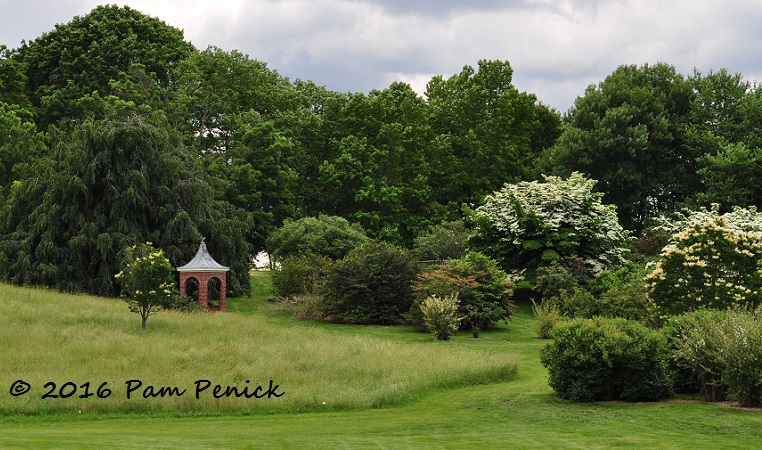
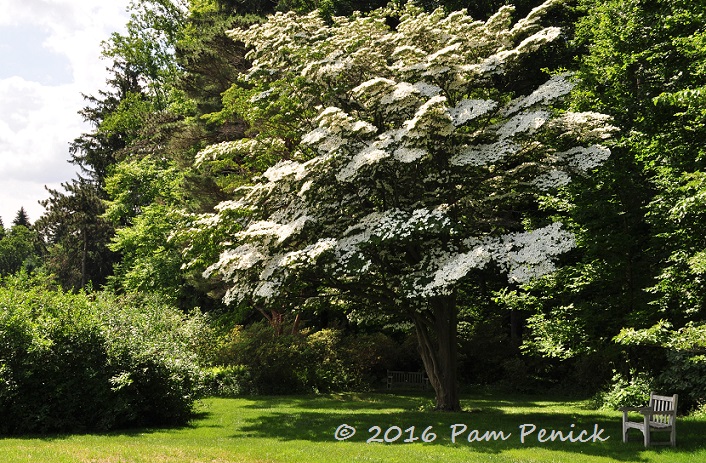
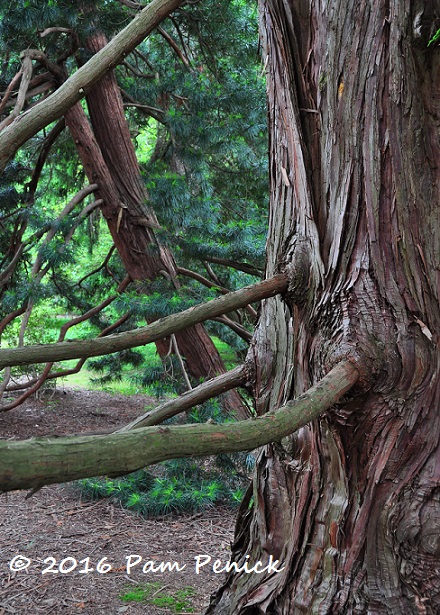
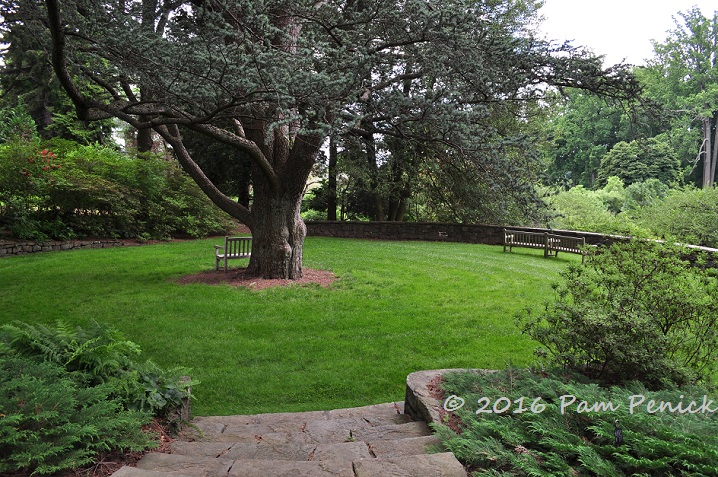
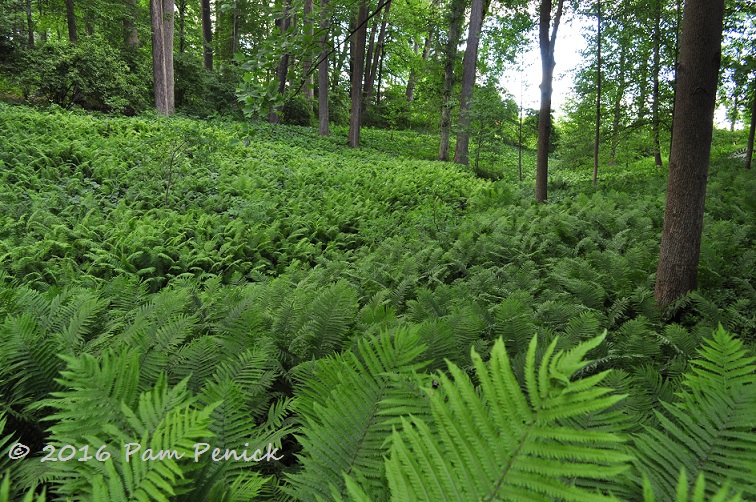
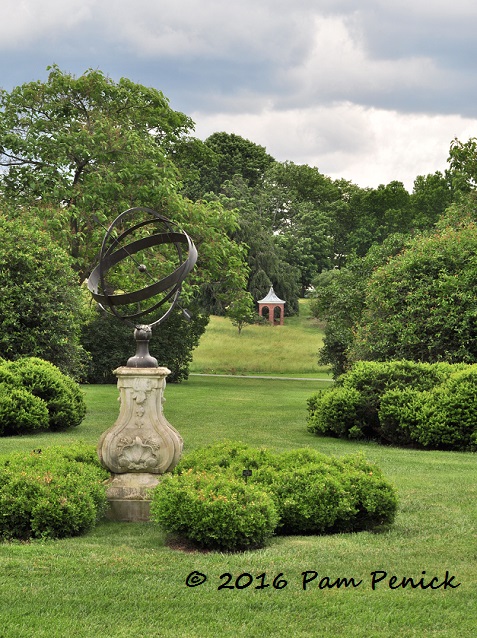
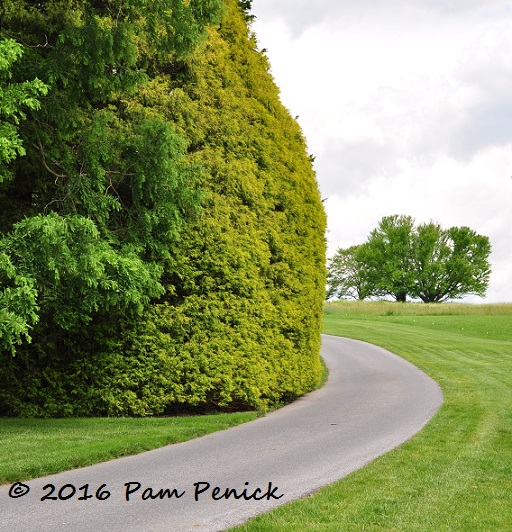
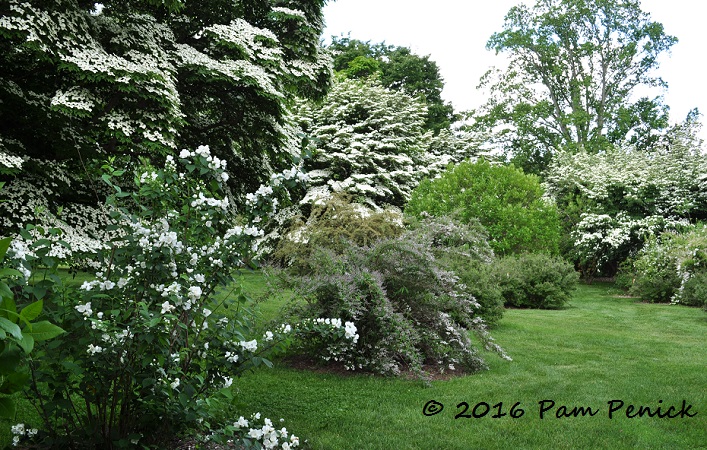
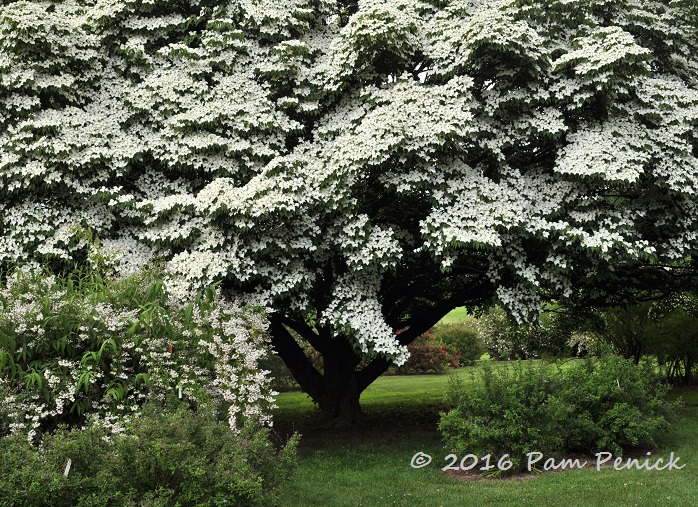
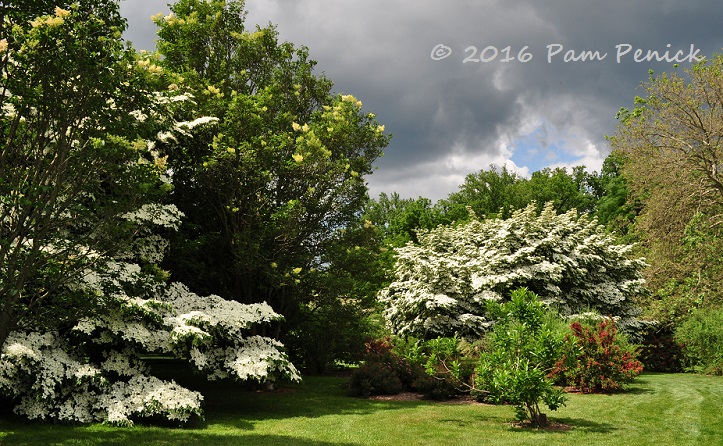
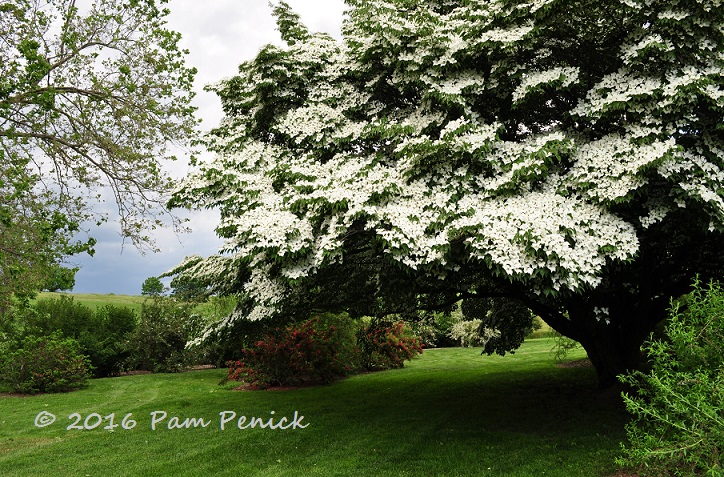
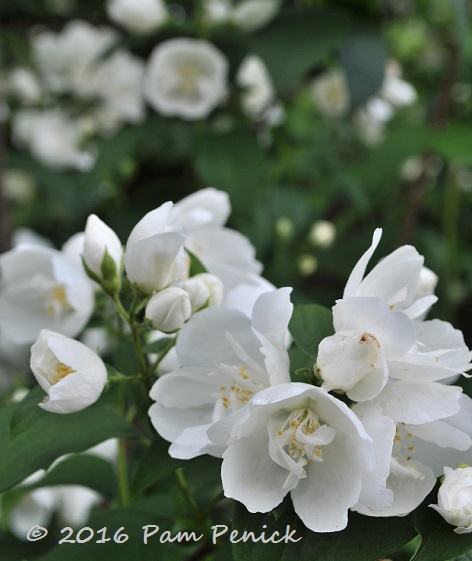
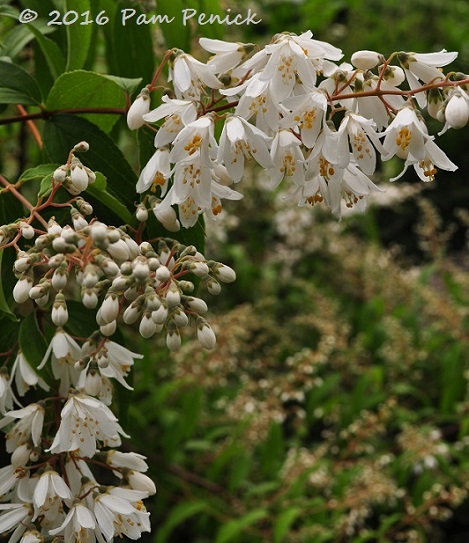
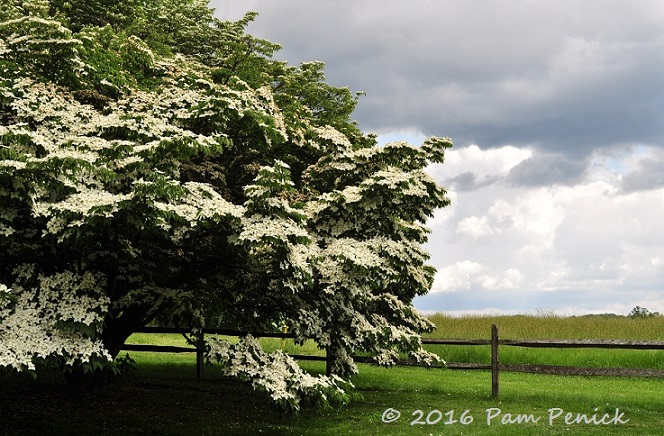
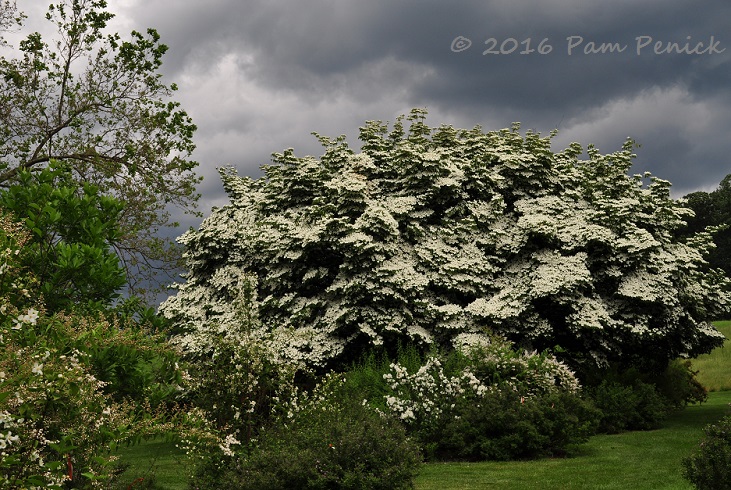
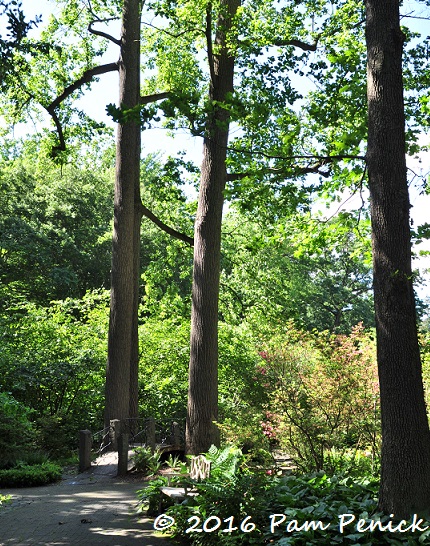
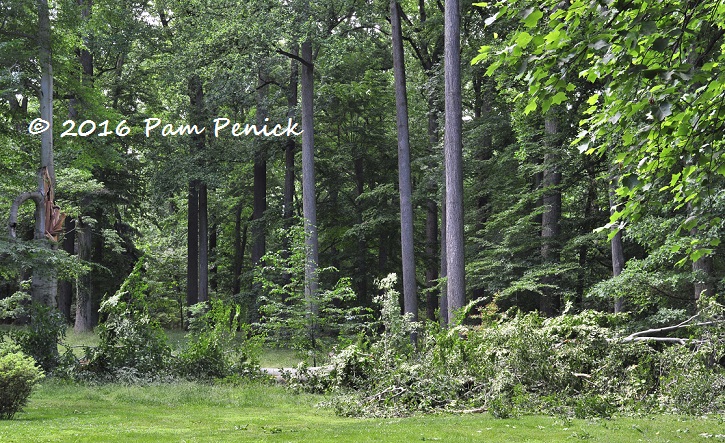
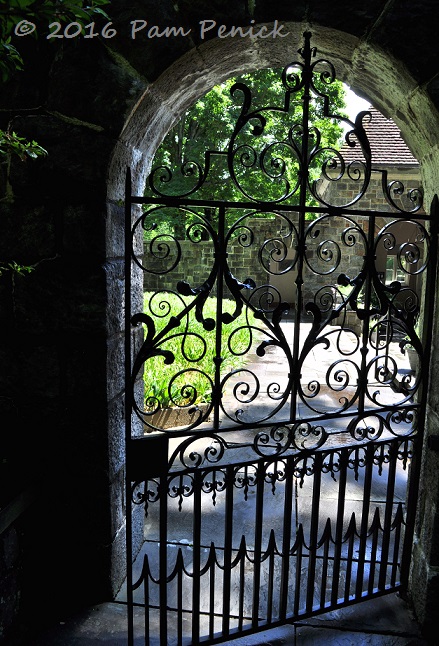
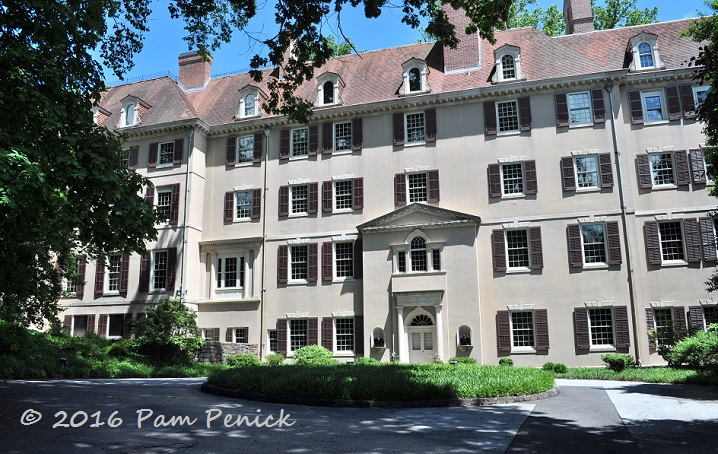
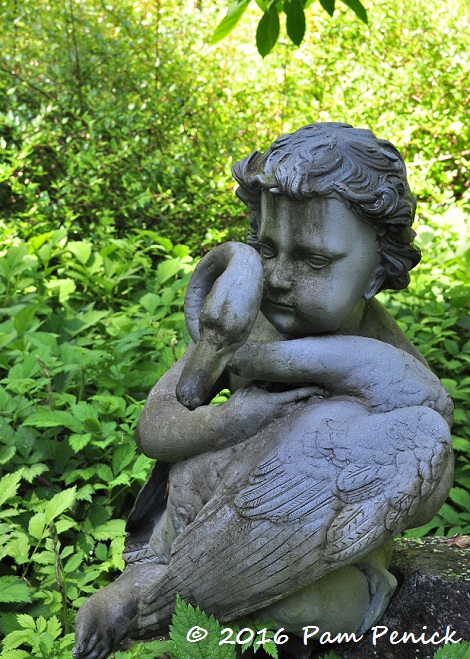
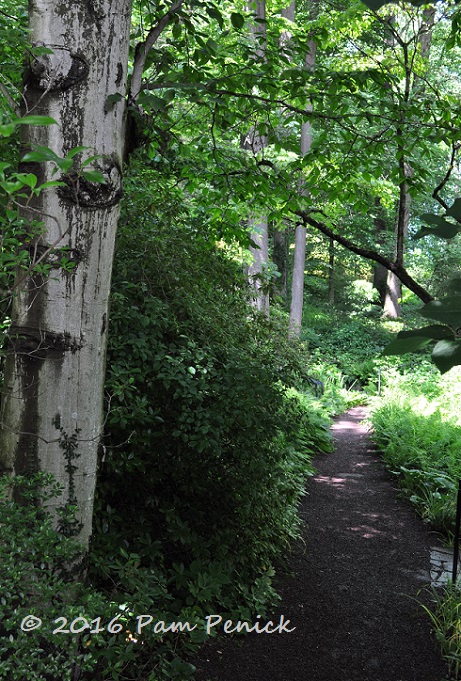
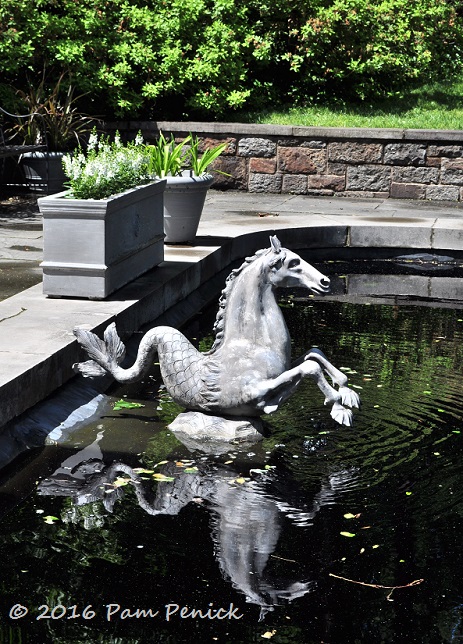
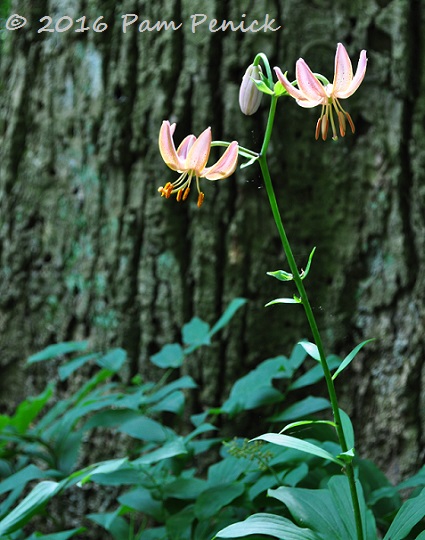
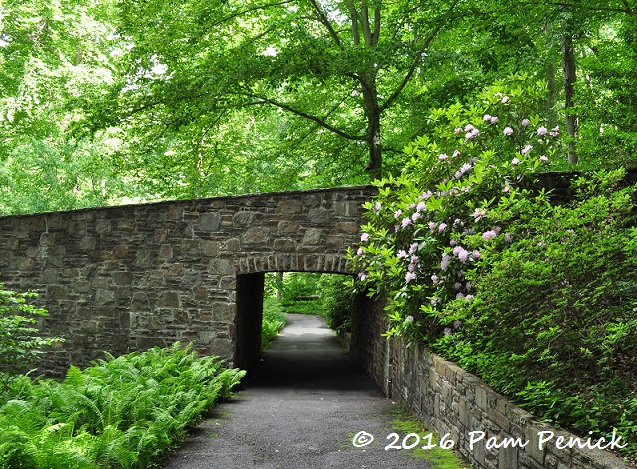

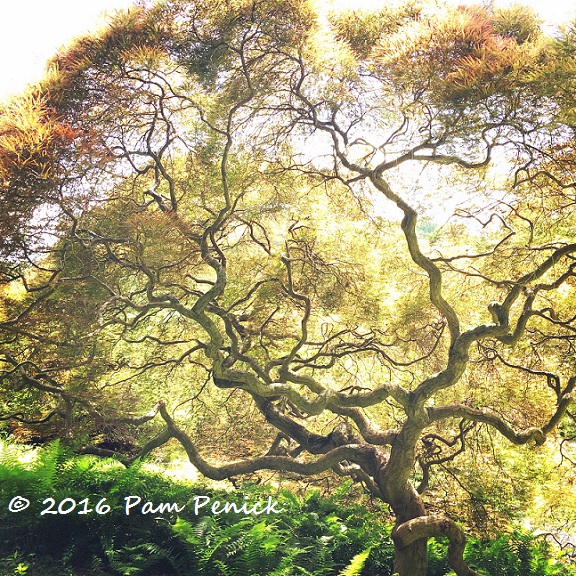
Aaahhh…memories! So glad we can laugh about it now. You captured the garden beautifully.
Right?? What a crazy, sudden storm — and crazy behavior. So glad we survived to tour another day. —Pam
Amazing garden and awesome pictures… Thanks for sharing
My pleasure! —Pam
Glad you are OK.
Oh, me too, Jeanette. 🙂 —Pam
Wow, it’s absolutely beautiful! Your story had me laughing, but in that storm in your shoes, I would have wet my pants.
The only good thing that came from it WAS that great laugh we had about it afterward. Almost made it worthwhile. 🙂 —Pam
What an amazing garden – but I have to say, how sad that war seems to generate such a lot of money! Thank goodness it also produced this amazing garden. I’m sure you will remember your hazardous visit for some time! Me, I won’t forget those incredible dogwoods. Thanks so much for sharing.
I think there’s often a tension between what industrial titans did to make their money and the philanthropy that is possible thanks to being that rich. Thank goodness for good works. The Du Pont family has a rich horticultural history in the Brandywine Valley, with heirs creating the gardens at Longwood, Mt. Cuba, and Nemours as well as Winterthur, and all are open to the public today.
I’m glad you enjoyed the dogwoods. They were breathtaking. —Pam
I wonder what the connection is, or might be to the Winterthur I know. A city in Switzerland.
Bruised, but still standing, Pam?
From the Winterthur website: “1837 — Jacques Antoine Bidermann and his wife, Evelina, a daughter of E. I. du Pont, purchase the property from the other siblings and begin construction on a 12-room house. They name it Winterthur after Bidermann’s ancestral home in Switzerland.” —Pam
wow, what a story! The garden looks beautiful (so green and white!) and i’m glad you guys are ok!
It was scary at the time but makes a good story now. That’s the way of it, right? And yes, the garden was lovely. —Pam
Pam, you and Diana took one of my bucket list trips! So fun to sit back and enjoy your awesome photos and that story of your storm survival! What great memories you’ll have of your trip together. Can’t wait to read the next post!
It’s coming soon, Melody — maybe even tonight. I’m glad you’re enjoying the Brandywine Valley pics! —Pam
I expected the pretty pictures but not the adventure story! I was a little concerned when I read that you ignored the first siren but as I’m one to ignore the first rattles of an earthquake, I suspect I might well have done the same, not wanting to miss the opportunity to see everything that famed garden has to offer. The dogwoods are the most impressive I’ve ever seen – I never realized the extent to which they could be blanketed in flowers like that.
The dogwoods reminded me so much of my years in North Carolina. We had several lovely trees, both white and pink, at our home there. I didn’t realize that dogwoods grew so far north. I mistakenly thought they were southern trees. —Pam
The photos of dogwood are amazing, Pam. It’s one of my favourite trees. I only wish they would survive in my cold climate.
I was surprised to see them growing in Pennsylvania, Pat. I thought they were only common in the South. —Pam
Having trees and branches fall all around you is no joke. I’m glad you survived untouched… or barely touched.
Yes, me too! —Pam
It’s an enchanting place. That massive tree (Cedrus atlantica, I believe) in the circular lawn was one of our favorite places to sit and pause. So glad you featured it. We bought a dwarf Cedrus cultivar and have it potted up in our Texas courtyard – just to remind us of the Winterthur granddaddy. Thanks for making me smile and pause again.
How lovely, Laura, to remember a special garden that way. —Pam
Just a note on the dogwoods — pretty sure those in bloom in June are all Cornus kousa. Native C. florida dogwoods bloom much earlier, in mid- to late April (maybe into early May north of here; I’m in western Virginia). I’m pretty sure Winterthur has its share of the native flowering dogwoods, too; it’s zone 7, like most of Virginia and North Carolina.
Good to know! Thanks for sharing that info, Nell. —Pam
Your exploits are much appreciated by one who leads a much more humdrum existence.
Ha, well, that much of an adventure was not part of the travel plan. 🙂 —Pam
I have always wanted to go there. Beautiful just as I imagined.
Road trip! —Pam